Historic Beginnings
American Japanese-style garden design in the 20th century.
The Storrier Stearns Japanese Garden represents a major phenomenon in American cultural history. The appreciation and assimilation of Japanese design concepts and aesthetics beginning in the late 19th century and subsiding with the outbreak of World War II. Japanese gardens and gardening played an integral role in the history of Japanese immigration and acculturation, particularly on the West Coast.
Fascination with Japanese culture.
The creation of Japanese-style gardens reflected American’s fascination with Japanese culture and fueled the boom in Japanese-style garden construction across the country.
The Storrier Stearns Japanese Garden is a superb example of the many private gardens that were a part of that phenomenon and one of the few still intact today. It was designed and created by Kinzuchi Fujii, a landscape designer and craftsman from Japan. His patrons, Charles and Ellamae Storrier Stearns, were wealthy benefactors of the arts and significant players in the cultural and civic life of Pasadena.Exquisite Teahouse
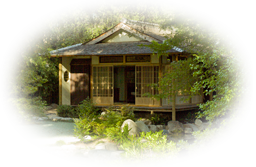
Authentic twelve tatami mat teahouse is the highlight of the garden, constructed using the original architectural plans and historic photographs.
The teahouse is named Niko-an, meaning Abode at Two Ponds. The original teahouse was built in Japan to Kinzuchi Fujii’s exacting specifications, then disassembled and shipped to Los Angeles for reassembly in the garden. The twelve tatami mats covering the floor (3' x 6' each) signified a teahouse of great importance.Kinzuchi Fujii’s son Frank possessed his father’s original plans and many photographs taken during the garden’s first construction. These were an invaluable resource during the garden’s recent restoration.
Though the original teahouse burned down in 1981, it has been rebuilt. Dr. Takeo Uesugi, an accomplished landscape architect and designer, worked closely with the current owners, Jim and Connie Haddad, to restore the teahouse, faithfully adhering to Kinzuchi’s original drawings, photographs and architectural plans.Early History
Significant Features
In addition to the classic Niko-an Teahouse, the garden landscape offers a variety of other beautiful details.
The Storrier Stearns Japanese Garden contains many of the much admired design features found in the most lavish of Japanese-style gardens of its era. As Kendall Brown states in his book, California Japanese-style Gardens, “this is the genius of Kinzuchi Fujii: this was once a flat area of two tennis courts; now it is a masterwork.”
- Numerous gathering points, seating areas & vistas
- Four original bridges plus the original cedar log Japanese Waiting Bench
- Two large interconnected, irregularly shaped koi ponds
- The sounds of two waterfalls, one cascading down a 25-foot hill
- An artful dry riverbed for rain overflow winding through the garden
- Cooling shade everywhere from spreading sycamores & old oaks
- Many tons of boulders & stones
- Granite statuary & stone lanterns
The Storrier Stearns Japanese Garden is a beautiful and charming retreat with a quiet and tranquil elegance.
Key Figures in the Storrier Stearns Japanese Garden History
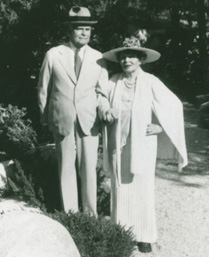
Charles & Ellamae
Storrier Stearns
Invested roughly $150,000 to create the garden on their Pasadena estate.
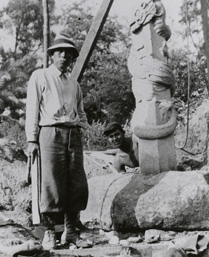
Kinzuchi Fujii
Master Landscape Designer
Spent a year designing, planning and preparing before construction began.
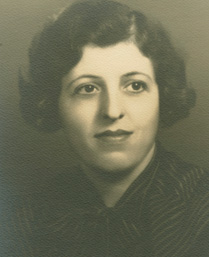
Gamelia Haddad Poulsen
Set out to buy two chairs at auction. Walked away with the entire estate.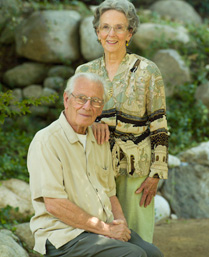
Jim & Connie Haddad
Today’s owners restored the garden for historical and cultural reasons andalso to honor Gamelia’s memory.